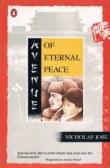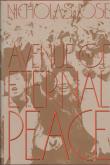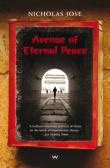
Latest Issues
AbstractHistoryArchive Description
'Beijing’s Avenue of Eternal Peace is the boulevard leading to Tiananmen Square. The world witnessed what happened there in May and June 1989, but ultimately came no closer to understanding the riddle of contemporary China than a TV screen montage. Now, in an atmospheric and penetrating novel that takes place a short time before the massacre, Nicholas Jose captures this city of contradictions, its people, and a moment in history much as Christopher Isherwood did for 1930’s Berlin.
Wally Frith, the hero-observer of this remarkable novel, is an Australian doctor and university professor specializing in cancer research. Middle-aged, emotionally bereft, recently widowed, he feels himself burnt-out. Therefore he readily accepts an invitation to come as a visiting professor to Peking Union Medical College, China’s leading teaching and research hospital. The prospect pleases: new scenes, new people, new life… and beyond these vague expectations, he has a particular goal–to meet Professor Hsu Chien Lung who, years before, had written a trail-blazing paper on cancer, and who Wally believes may still be on the faculty there. But Professor Hsu seems to have vanished; perhaps he never existed. The search, which has its macabre as well as comic elements, is stalled, and Wally meanwhile immerses himself in the ordinary (sometimes extraordinary) life of Beijing, newly exposed to Western influences, and in a state of vigorous contradiction.
This extraordinary, kaleidoscopic, multi-leveled novel shows us a China the TV cameras couldn’t photograph–the China inside the hearts of its people. It is a moving and revelatory experience by a writer who was a witness to history and to a people’s dreams.'
Source: Author's website.
Notes
-
Avenue of Eternal Peace was filmed for television as Children of the Dragon (1992) by Southern Star Xanadu and Zenith for ABC TV and the BBC, starring Bob Peck, Linda Cropper, Gary Sweet and Lily Chen, directed by Peter Smith.
-
Epigraph:
Not that there are no ghosts
But that their influence becomes propitious
In the sound existence of a living man'
There is no difference between the quick and the dead,
They are one channel of vitality. -Lao Tzu
...a country so strange that not even the air had anything in common with his native air, where one might die of strangeness, and yet whose enchantment was such that one could only go on and lose oneself forever. - Franz Kafka
Perhaps I should tell the children
A tale. -Yang Lian
Publication Details of Only Known VersionEarliest 2 Known Versions of
Other Formats
- Also sound recording.
- Also large print.
Works about this Work
-
A Semiotic Reading of Nicholas Jose’s Avenue of Eternal Peace
2019
single work
criticism
— Appears in: Language and Semiotic Studies , Spring vol. 5 no. 1 2019; (p. 45-64)'Nicholas Jose has been advocating “transcultural writing” for more than three decades, with Avenue of Eternal Peace (1989) as an early part of his practice. In 1990, Avenue was short-listed for the Miles Franklin Prize but failed to win this Australian national award. Judged by Chinese semiotician Zhao Yiheng’s reception model of narratives, this is a “message blocked” case. Using the framework of Roman Jakobson’s communication model, this paper reinterprets the six constitutive factors and functions to investigate the elements that blocked the message. My main argument is that “contact”, “context”, and “code” jointly blocked the communication; the three Cs reflect three long-standing problems in Australian literature: the issue of cultural identity, the dark side of White Australian Dream, and the Orientalist representation of “the other” culture. The failure in literary communication analyzed also suggests that Wally’s perception of China follows a Saussurean dichotomy which presupposes a closed linguistic system and excludes the role of the subject and the extra-semiotic object in signification. The Peircean trichotomy better captures the process of concept formation and is a better approach to transcultural writing in the contemporary postmodern situation. Transcultural writing challenges its readers; we need to transcend our confined nationality and persistent prejudice, and develop adequate “transnational literacy” to appreciate this new form of cultural production.'
Source: Abstract.
-
The Treatment of Other Cultures in Transcultural Writing—A Cognitive Semiotic Reflection
2017
single work
criticism
— Appears in: Language and Semiotic Studies , Spring vol. 3 no. 1 2017; (p. 31-61)'Transcultural literary studies as advocated by Italo-Australian critic Arianna Dagnino claims to investigate writers who live transnational lives and write out of a border-crossing and transcendent sensibility. But, in arguing for indeterminacy and fuzziness in transcultural novels, it fails to explain how specifically different cultures should be dealt with in this type of writing. In this essay, [the author draws] on Per Aage Brandt’s cognitive semiotic definition of cultural “sedimentation” as opposed to Raymond Williams’ “analysis of culture” to help with a close reading of two Australian travel novels of the 20th century, i.e. Margaret Jones’ The Confucius Enigma and Nicholas Jose’s Avenue of Eternal Peace, with special attention to how the two books handle Chinese culture. Such a reading reveals that, while both novels are set in China, the former remains satisfied with minimum cultural representation, and the latter mainly focuses on certain areas of contemporary Chinese culture instead of others. Although Avenue of Eternal Peace does dig beyond the “iconic meanings” of the Chinese culture to reveal authorial knowledge of its “symbolic meanings”, the novel devotes too much of itself to the overwhelmingly “negative semiosis” of China, reflecting a complacent attitude on the part of the protagonist/narrator/author towards Chinese culture. For this reason, neither novel meets Dagnino’s criteria for transcultural writing. And the two novels start us thinking about Dagnino’s theorization of transcultural writing because her emphasis on “transcending” only implies an aloofness and detachment. Brandt’s definition of culture as sedimented symbolic meanings teaches us that genuine transcultural writers should perhaps be prepared not just to know and understand and stay at a distance from other cultures but to engage and heartily share and even partake of their sedimented symbolic meanings at all levels and learn to feel the same way about them as their native members. This is true of the third world diasporic/migrant writers living and writing in the first and second worlds that Dagnino’s theory of transcultural writing remains focused on, but even more of the first and second worlds writing about their transcultural experiences in the third world countries. I argue that part of the intention of Dagnino’s transcultural literary studies is to move beyond postcolonialism’s concern over cultural unevenness and asymmetry, but this study proves that postcolonialism is not and should not be taken as completely over.'
Source: Abstract.
-
Nicholas Jose’s “Trans-cultural Writing” in Avenue of Eternal Peace
2016
single work
criticism
— Appears in: Contemporary Foreign Literature , vol. [2016] no. 3 2016; (p. 92-100)'Avenue of Eternal Peace is an early novel written by Australian novelist Nicholas Jose. Set completely in China, the novel presents a panoramic description of a foreign culture with which the author has been closely associated. In that sense, it is Jose’s first "trans-cultural" novel. Jose claims that the novel represents an attempt on his part as an Australian writer to translate China. Indeed, Avenue of Eternal Peace offers a fascinating translation of Chinese culture. To Jose, cultural translation is different from interlingual translation because it all happens intralingually: it integrates the author’s understanding of the source culture and expression of it in the same process. In so doing Jose shapes his knowledge of a foreign culture through his own language and directly presents it to members of his own culture. This essay first looks into the contents of the Chinese culture in Jose’s translation. Employing what Raymond Williams refers to as the "three levels of culture", namely, the lived culture, the recorded culture and the culture of selective tradition, it then examines Jose’s translation strategies and offers a discussion of the underlying reasons. It concludes that the way in which Jose translates China in his early "trans-cultural" novels betrays a lot of affinities with what Bill Ashcroft calls the "transnational" writing in some postcolonial discourse.
'《长安街》是澳大利亚小说家尼古拉斯·周思早期创作的一部中国题材小说,也是他积极践行的一部"跨文化书写"小说。在这部作品中,周思立足澳大利亚对中国进行了多方位的文化解读。周思把"跨文化书写"看做是一种文化翻译,《长安街》中的文化翻译不同于普通意义上的文字翻译,因为它将作者对中国文化的理解和向西方读者的表达合二为一,努力传达小说家对于中国文化的认识。本文立足澳大利亚理论家比尔·阿希克罗夫特的后殖民文学理论,借用雷蒙德·威廉斯的三级文化分类法,从"亲历文化"、"纪录文化"和"选择性的传统文化"三个方面考察《长安街》对于中国文化的翻译策略、方法和视角,从中观察周思早期中国小说的特点以及这种"跨文化书写"中所反映出的后殖民话语特征'
Source: CAOD.
-
The Year the Dragon Came : Post-Tiananmen Stories
2013
single work
criticism
— Appears in: Telling Stories : Australian Life and Literature 1935–2012 2013; (p. 444-451) -
Book Review – Avenue of Eternal Peace by Nicholas Jose
2011
single work
review
— Appears in: Booklover Book Reviews 2011;
— Review of Avenue of Eternal Peace 1989 single work novel
-
Untitled
1990
single work
review
— Appears in: Fremantle Arts Review , April vol. 5 no. 4 1990; (p. 15)
— Review of Avenue of Eternal Peace 1989 single work novel -
Untitled
2008
single work
review
— Appears in: Transnational Literature , November vol. 1 no. 1 2008;
— Review of Avenue of Eternal Peace 1989 single work novel -
This Year's Work in Fiction 2008-2009
2009
single work
review
— Appears in: Westerly , July vol. 54 no. 1 2009; (p. 51-64)
— Review of The Pages 2008 single work novel ; The Lieutenant 2008 single work novel ; The Spare Room 2008 single work novel ; The Anatomy of Wings 2006 single work novel ; Boy On A Wire 2009 single work novel ; The Sinkings 2008 single work novel ; Bird 2008 single work novel ; One Foot Wrong 2008 single work novel ; Avenue of Eternal Peace 1989 single work novel ; Life in Seven Mistakes 2008 single work novel ; The Steele Diaries 2008 single work novel ; Butterfly 2009 single work novel ; Dissection 2007 single work novel ; Fugitive Blue 2008 single work novel ; Sweet 2008 single work novel ; The Virtuoso 2009 single work novel ; Ransom 2009 single work novel ; The Good Parents 2008 single work novel ; Vertigo : A Pastoral 2008 single work novella ; The Boat 2008 selected work short story ; New Australian Stories 2009 anthology short story ; The Slap 2008 single work novel -
An Updated Novel for an Updated China
2009
single work
review
— Appears in: Antipodes , June vol. 23 no. 1 2009; (p. 96-97)
— Review of Avenue of Eternal Peace 1989 single work novel -
Rivers of Feeling from an Unexpected Source
1989
single work
review
— Appears in: The Australian Magazine , 18-19 November 1989; (p. 8)
— Review of Playing in the Sand 1988 single work novel ; Avenue of Eternal Peace 1989 single work novel -
Literary Constructions of the Near North
1991
single work
criticism
— Appears in: An Australian Compass : Essays on Place and Direction in Australian Literature 1991; (p. 186-210) -
Nicholas Jose : 'Travellers Among Mountains and Streams'
1995
single work
criticism
— Appears in: Southwords : Essays on South Australian Writing 1995; (p. 160-177) -
Jose Records City's Hopes and Despairs
1989
single work
review
— Appears in: The Canberra Times , 22 October 1989; (p. 19) -
Screen Dreams and Nightmares
1992
single work
criticism
— Appears in: Modern Times , March 1992; (p. 22-24) From Yellow Earth to Eucalypt : Stories and Poems from China and Australia 1995; (p. 137-144) -
Jose's Fiction on Inscrutable China, No Sooner Said Than Done
1989
single work
criticism
— Appears in: The Saturday Mercury , 30 September 1989; (p. 16)
Awards
- 1990 shortlisted Miles Franklin Literary Award
-
cChina,cEast Asia, South and East Asia, Asia,





